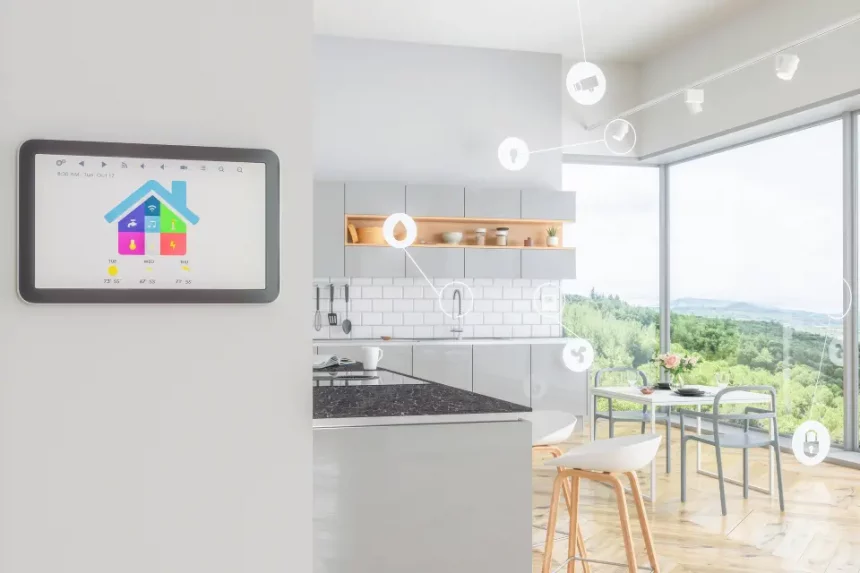Home automation is all the rage in the modern world. With the help of smart devices, it’s never been easier to automate mundane tasks and get the most out of your home. Whether you’re looking to turn off lights, check the weather, or manage your entertainment system, home automation can offer an unprecedented level of convenience.
With the right setup, it’s easy to unlock all of the benefits of a connected home. From security and energy savings to convenience and entertainment, home automation can help you make the most of your home. With the help of the latest technology and some clever planning, you can create a truly connected home that helps you get the most out of your living space.
1. What is home automation?
Home automation refers to the ability to control various devices from a centralized location. By connecting devices to a central hub, you can manage and control them from a single interface. While the concept of home automation has existed for some time, the latest tech has made it easier than ever to realize its benefits.
You can automate almost anything in your home, from the lights to the climate control and beyond. With the right setup, you can create a truly connected home that helps you get the most out of your living space. Home automation allows you to create a truly connected home that helps you get the most out of your living space.
The best part is that you don’t have to be an engineer to create a well-connected home. Simply choose the right devices and a platform that offers seamless connectivity.
2. Benefits of home automation
At its core, home automation is about making life easier. Whether you use it to save time, money, or energy, home automation is a great way to improve the overall experience of home ownership. –
Time savings – Perhaps the most obvious benefit of home automation is the time savings it can provide. From controlling your lights to creating schedules, home automation can help you save time on menial tasks. You can also improve the quality of your time by using home automation for entertainment or communications. –
Money savings – Home automation can help you save money in many ways. Whether you’re trying to reduce your energy or water bills, or you’re looking for ways to reduce your overall maintenance costs, home automation is an excellent choice. –
Environmentally friendly – Home automation gives you the ability to create an environmentally-friendly home. Whether you’re looking to reduce your carbon footprint or you’re concerned about rising energy costs, home automation can help.
Convenience – Perhaps the most important benefit of home automation is the convenience it provides. From controlling your lights to managing your security, home automation makes it easier to live in the modern world.
3. Types of home automation
– Lighting – Lighting is one of the most common forms of home automation. There are many different ways to control your lights, from smart bulbs to apps, switches, and voice control. – Environment control –
Another popular form of home automation is climate control. You can integrate various aspects of your home’s HVAC system, including temperature sensors, thermostats, and smart switches. – Security and safety – Another common form of home automation is security and safety.
You can use home automation to monitor your home, manage your security systems, and even track the health of loved ones. – Entertainment – You can also use home automation for entertainment. This includes entertainment systems, media and gaming systems, and even toys.
4. Home automation safety considerations
While home automation can provide many benefits, it also comes with some safety considerations. The most important thing to remember is that you should choose the right system and ensure that it is properly integrated and configured. You don’t want your lights turning on and off without warning, or your security system failing to sound the alarm.
Carefully consider each system and choose products that work together seamlessly. Another important consideration is user experience. You want to make it as easy as possible for your family members to use the system. Whether you’re connecting physical products or using a smartphone app, you want to make sure the system is easy to understand.
5. Home automation setup
To get the most out of your home automation setup, you’ll first need to carefully plan your system. Start by creating a list of your must-have features, as well as a list of nice-to-haves. From there, you can start to map out your system and determine how everything will connect. Once you’ve planned your system, it’s time to take action.
You have a few options when it comes to installing your system, including hiring a professional or doing it yourself. No matter which option you choose, you’ll first need to research your best options and select the right products to meet your requirements. From there, plug your products into your system and begin enjoying the benefits of home automation.
6. Home automation products
There are many different products for home automation, and you can find something to meet your needs. Whether you’re looking for smart lights, thermostats, or security systems, you can find products that fit your budget and provide valuable functionality. Here are a few of the most popular home automation products. –
Lighting – Lighting is one of the most common products for home automation. There are many different lighting options, including smart bulbs, smart switches, and smart light strips. –
Security – Another common product is security. You can use home automation to manage your security systems, monitor your home, and track the health of loved ones. –
Climate control – Another popular product for home automation is climate control. You can integrate various aspects of your home’s HVAC system, including temperature sensors, thermostats, and smart switches. –
Entertainment – You can also use home automation for entertainment. This includes entertainment systems, media and gaming systems, and even toys.
7. Home automation apps
One of the easiest ways to take advantage of home automation is to simply use an app. There are many home automation apps available, including Apple’s Home app, Google Assistant, Samsung SmartThings, and more. Simply install your app and create your system to start managing your devices remotely.
Home automation apps are also used to control your systems. You can create schedules, adjust your lights, and control other aspects of your home remotely.
8. Home automation systems
If you’re looking for something a bit more robust than a collection of smart devices, you can also consider a home automation system. These systems come with a central hub, allowing you to control your devices and appliances via your smartphone or other device. They also allow you to create rules and schedules for your home, which can help you save even more time and energy.
There are many different home automation systems available. You can choose from wired or wireless systems, and you can find systems that are designed for specific features, like security or climate control. These systems provide a great way to get the most out of your home automation setup.
9. Home automation services
Beyond physical products, you can also take advantage of home automation services. Services like IFTTT, Stringify, and Nest all offer ways to automate your home, save energy, and create a truly connected home.
With these services, you can easily create rules that integrate many different products. From your thermostat to your entertainment system, these services give you a way to create truly seamless home automation.
10. Home automation tips
Home automation is an excellent way to improve the functionality of your home. With the right setup, you can create a truly connected home that helps you save time, money, and energy. To get the most out of your home automation system, here are a few tips to keep in mind: –
Choose the right products – Before you begin your home automation journey, you need to know what products you want to use. From bulbs to switches and beyond, there are many different products you can use. –
Plan your system – Once you know what products you want to use, it’s time to plan your system. Start by creating a list of must-have features, as well as a list of nice-to-haves. From there, you can map out your system and determine how everything will connect. –
Install and configure your system – Once you’ve selected your products and created your system, it’s time to install and configure your system. Simply follow the instructions included with your products, plug them into your system, and begin enjoying the benefits of home automation. –
Use IFTTT and other services – Beyond physical products, you can also take advantage of home automation services. Services like IFTTT, Stringify, and Nest

















